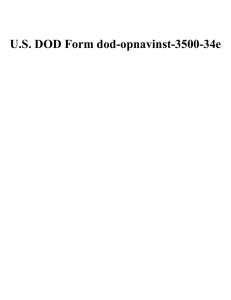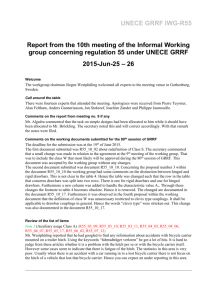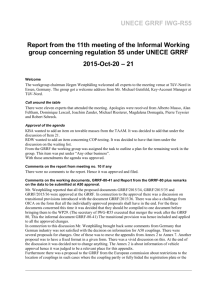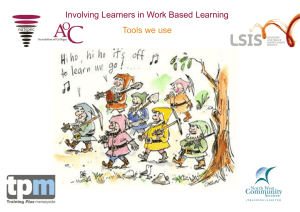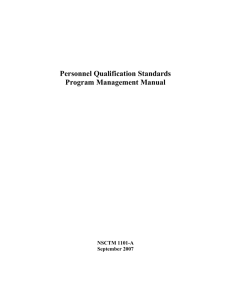PRACTICE OBSERVER`S ASSESSMENT REPORT
advertisement
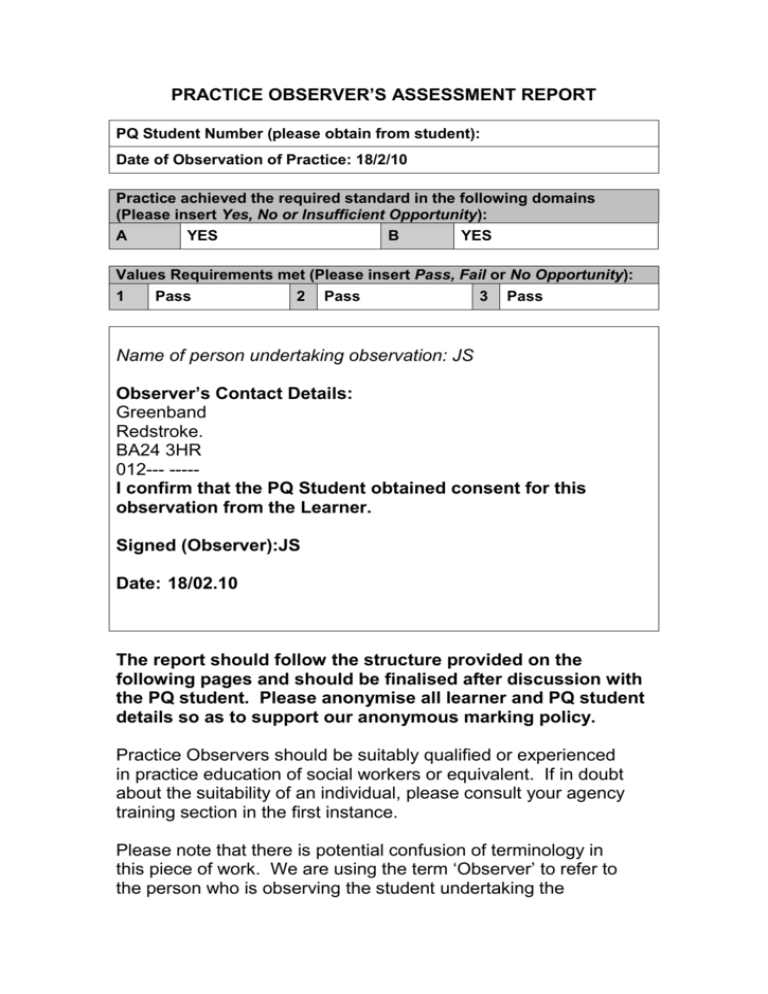
PRACTICE OBSERVER’S ASSESSMENT REPORT PQ Student Number (please obtain from student): Date of Observation of Practice: 18/2/10 Practice achieved the required standard in the following domains (Please insert Yes, No or Insufficient Opportunity): A YES B YES Values Requirements met (Please insert Pass, Fail or No Opportunity): 1 Pass 2 Pass 3 Pass Name of person undertaking observation: JS Observer’s Contact Details: Greenband Redstroke. BA24 3HR 012--- ----I confirm that the PQ Student obtained consent for this observation from the Learner. Signed (Observer):JS Date: 18/02.10 The report should follow the structure provided on the following pages and should be finalised after discussion with the PQ student. Please anonymise all learner and PQ student details so as to support our anonymous marking policy. Practice Observers should be suitably qualified or experienced in practice education of social workers or equivalent. If in doubt about the suitability of an individual, please consult your agency training section in the first instance. Please note that there is potential confusion of terminology in this piece of work. We are using the term ‘Observer’ to refer to the person who is observing the student undertaking the Practice Education unit. We have used the term ‘PQ Student’ to refer to the person whose practice is observed, and ‘Learner’ as the person with whom the PQ student is working. 1. The Observer is asked to observe and assess the chosen session, addressing each Practice and Values Requirement specified for the assessment task and report on how the PQ student met these during the observed session: PRACTICE REQUIREMENTS COMMENTS PQ students are required to demonstrate their ability to Contribute to the professional development of others. To do so, they must show competence in three areas (or ‘domains’), the first two of which (A & B) are addressed in the observed session, as set out below. Examples of activities that may be undertaken to demonstrate each requirement are listed under the headings A & B. Not all these activities need to be undertaken, but practice observers should assure themselves that a sufficient range of competence has been demonstrated for each domain to have been met (A & B). Practice observers should comment on those activities that apply (and write N/A against those that don’t). Evidence may be used from discussion with the PQ student before and after the observation, as well as from the observation itself. A: Organise opportunities for learning Please make brief comments on how these competences were met, using evidence from your observation and from discussions with the PQ student. 1. Create an environment conducive to demonstration of learning. PQS suggested that the observation should take place in a smaller office rather than the large room that was also available; creating a more relaxed environment. She ensured that everyone had a drink and began by talking casually on a variety of topics before commencing the feedback on the previous days direct observation with L. 2. Negotiate and arrange the necessary resources and learning opportunities. PQS had ensured L received a thorough induction and has arranged a wide variety of work opportunities. She has encouraged her to shadow and co-work with multi-disciplinary colleagues. She told L how much colleagues enjoy working with her as she brings fresh ideas to practice. 3. Work openly and co-operatively with all concerned. PQS as L’s practice assessor has sole responsibility for L’s learning but has involved a wide range of colleagues to enhance the learning opportunities. 4. Co-ordinate the work of all contributors and brief them PQS has ensured that the wider team members are aware of L’s learning needs and she had prepared the appropriately. 5. team appropriately before the placement began. Monitor the continuing suitability of PQS monitors L’s on-going learning the learning environment. needs through planned and ad hoc supervision. This has included L coworking complex cases. Any other comments B. Enable learning and professional development in practice 1. Establish an effective working relationship with the learner(s). PQS and L. clearly had an excellent relationship they shared humour appropriately when discussing the problems of arranging the direct observation. They were able to discuss difficulties openly and PQS was able to acknowledge if she didn’t have an answer to a problem saying, ‘we’ll ask O afterwards’; this created a sense of sharing and joint learning. 2. Identify, manage and review any particular needs of the learner(s). PQS was very aware that L’s confidence had received a knock having failed a written assignment. She therefore made sure that she gave clear and detailed positive feedback that enabled L. to understand her strengths in practice. She then went on to discuss learning points in a positive and supportive way. 3. Take account of individual learning PQS like L. has dyslexia and is able styles, needs, prior achievements, to empathise and make practical knowledge and skills. suggestions about how this can be supported in the placement. She has shown L. how to set up the email system so that it automatically spell checks her emails and the support staff both type and proof read documents. During L’s induction PQS had arranged for L to familiarise herself with total communication and acknowledged L’s prior learning in signing as being very useful in her current placement. She acknowledged the range of skills that L had used in the direct observation and her calmness in dealing with the unexpected crisis situation. 4. Make judgements about meeting learners’ needs, within appropriate resources and required learning outcomes. PQS was clear that L was meeting both her occupational standards. She discussed anti-oppressive practice and the value statements met within the observation and wider work being undertaken. 5. Identify learners’ responsibilities within the learning process. PQS encouraged L to identify which key roles she thought she had met through her direct observation and how she had met them. 6. Agree how the learning is to be reviewed. 7. Advise and support learners with regard to managing their own learning. Advised L about where she could go to obtain information she needed. Any other comments VALUES REQUIREMENTS COMMENTS 1. PQS made clear that she understood both the power imbalance inherent in the roles of student and assessor and how she would seek to empower L. whilst acknowledging her assessment role and the need protect service users from poor practice. Identify and question own values and prejudices, the use of authority and power in the assessment/supervision/mentoring relationship, and recognise and act upon the implications for their practice in supporting and assessing learning. PQS shared her own learning difficulties with L. and what this had meant when she was a student. She also encouraged L. to share in evaluating the learning achieved in the direct observation. 2. Respect and value the uniqueness PQS was able to discuss L’s past and diversity of learners and their experiences and how she had drawn circumstances, recognise and on this to support the service user. build on their strengths, taking account of individual learning styles. 3. Assess and support learning in a When PQS fed back learning points manner that does not stigmatise, disadvantage or discriminate against individuals, ensures equality of opportunity, and counters unjustifiable discrimination in ways appropriate to situation and role. she did so respectfully. She has also made sure that L. is supported in her report writing and distinguished between the problems encountered because of L’s dyslexia and L’s ability to know what, when and how she should record which she praised. 1. The Observer is asked to comment on the overall quality of the session, taking account of discussions with the learner. PQS acknowledge that she was nervous and so had made clear written notes in the format that will provide the written feedback with particular points highlighted. Although feeling nervous PQS took time to put L. at ease making sure she had a drink and talked about general issues first. PQS began with positive praise for the way that L. had dealt with a difficult crisis situation and the negotiation that she had undertaken to ensure the visit could go ahead. PQS was clear about the skills L. had used; particularly about the way she had structured the interview in a way that allowed the service user space to express her distress and concerns whilst being able to draw her back to what needed to be done. PQS was also clear about the values L. has displayed even when she had needed to explain to the service user that she would be arrested should her behaviour re-occur. She praised L. for the way that she had handled the emotional content of the meeting and her use of self. She affirmed that L. had demonstrated her use of theory in a number of ways discussing the exchange model of communication and how L. had remained person-centered throughout. At one point PQS noticed L. becoming distressed and dealt with this sensitively offering to take a break and suggested that they make a drink? However when L. wished to continue PQS did not make an issue of this and continued quite naturally with the feedback. PQS acknowledged subsequently that she had momentarily touched L’s arm when she had become distressed and remembered when a student herself she had been told that such touch was inappropriate. We discussed whether this was inappropriate but agreed that human touch can be important when some one is distressed providing it is not unwelcome. PQS explored L’s work with the service user in a broader context considering health and safety issues around violence and the importance of sharing knowledge to keep colleagues safe and the importance of accurate and timely record keeping all of which L. had undertaken following the visit. Throughout the session PQS provided examples of how L. had demonstrated good practice which provided a good basis for future learning. L found PQS clarity particularly helpful and felt that she is always able to follow what PQS is saying. She finds that PQS is able to help her reflect on her practice and puts her at ease during discussions always making her feel that her opinions are valued. 2. The Observer is asked to summarise specific learning points and areas for development arising out of the observation. Due to the nerves that PQS was feeling she spoke quite quickly which could have made it difficult for the learner to follow if they were equally nervous. PQS suggested that L might like to identify the Key Roles achieved but still went on to do most of this her-self. Perhaps agreeing to take this in turns might be a good way of sharing power and learning. 4. PQ student’s self-evaluation. LEARNING POINTS AND AREAS FOR DEVELOPMENT: I have learned from the feedback given to me that I have some things I do well, as well as other areas I need to continue to develop in. I was pleased to read in regards to my feedback to the student, that it was clear and that the notes I had prepared before the meeting, made sure I was aware of each stage I was at throughout the meeting. This has taught me to always prepare detailed notes before feeding back any information, regardless of the setting, as it helped me to remain focused and not loose my way. Therefore, I felt I had a clear beginning, middle and end to the meeting, without leaving out any important information. I found it useful to know I was able to put the student at ease, even though I was very nervous myself. During my direct observation I learned that I could think on my feet while being observed when the student became distressed, which I am used to doing with service users and carers. However, I have not had a lot of experience of professionals or colleagues getting upset in a formal meeting. I was not aware at the time of my direct observation that I was speacking fast (I was aware of my nervousness). Therefore, I need to be aware in future of the speed at which I am speaking, slowing my speech down when feeling nervous. I also need to think about incorporating periods of silence to slow down my talking and allow the learner to digest the information I am sharing. As well as allowing more space for the student to make comments during the feedback. I was aware that during the feedback I said that the learner and I would go through the key roles together. After the event, I realised that I took over and gave all my thought in relation to key roles that had been met by the student, not allowing the student to express her thoughts. Therefore, instead of sharing suggestions and allowing the student to express her thoughts on this subject, I did not share the balance of power equitably between us. In future I need to think about what I have said , to reflect in the moment and keep to the suggestions I make. I also need to share responsibility of highlighting issues/points to share the balance of power with the learner. Comments on the Observer’s Feedback I was very happy with the feedback provided. It was clear and easy to follow. It has assisted me to reflect on my practice as an assessor and supervisor. It has enabled me to look at the positive areas in my practice as a supervisor/observer, which in turn has provided me with more confidence within my role. The feedback highlighted my own social work values. I also liked the way the observer confirmed that I could point out to the student, her use of social work values in her practice. I was pleased that the feedback was able to inform me of areas where I need to develop further. It highlighted part of my practice of which I was unaware ie that I needed to slow my speech down when nervous .These pointers enable me to focus on these areas required to improve my professional development. I was also pleased that the observer got her written report back to me shortly after the observation took place. This meant the observation was still fresh in my mind, making reflection an easier and natural process for me. I am the senior social worker in a Community Team for Adults with a Learning Disability. I have been in my current role since January 26th 2009. Before this date I was a social worker in the Older Persons Mental Health Team working for the partnership. To complete the Practice Educators module I took on a third year social work student on placement from X University for the period of one hundred days. The student is a white British female, divorced and has a statement of Dyslexia, with myself also being a white British female, divorced with a statement of dyslexia. However, this is where our similarities end. The student is over ten years younger than me; she has experienced mental health difficulties, which I have not. I was seconded to do the social work course, while the student is doing it directly . Therefore, she is also holding down a part time job, where as I was paid by the Council throughout the course. She has required a lot of emotional support and has had difficulty viewing me as a professional she works with, appearing to view me more in parts as a personal friend. She has invited me to her graduation, which I do not see as appropriate for me to attend. This is very different from my value base, with me liking to keep my working life very separate from my personal life. I have also been able to recognize that although both the student and I both have a statement of dyslexia, it affects us both in different ways, with us both having different forms of abilities and strategies to cope with our disability. I have completed two direct observations and written up the reports from the direct observation, to go into the student’s portfolio. I have supervised the student weekly while on placement. I have also written up the student’s midway and final placement report. With permission from the student, my observer who is a qualified social worker and Practice Learning Development officer, observed me giving the student verbal feedback on her first direct observation. I had observed the student carryout a review, with a twenty-year-old white female who is the perpetrator of domestic violence to her live in partner. The student required the feedback to write up her reflection on the piece of work. While I was being observed giving feedback to the student, she started to cry. This took me by surprise, as I was giving positive feedback on her practice at the time. However, after discussion with her, it became clear that was why she was crying, as she was expecting negative views, due to a recent experience at university where she had been bullied. During the time the student was in tears, I offered the student to have a drink and short break, which she declined. I later provided the student with a written report of my observation of her work.

